Python是进行数据分析的一种出色语言,主要是因为以数据为中心的python软件包具有奇妙的生态系统。 Pandas是其中的一种,使导入和分析数据更加容易。
Pandas dataframe.mul()函数返回数据帧和其他元素的乘法。此函数本质上与dataframe * other,但它提供了额外的支持来处理其中一个输入中的缺失值。
用法: DataFrame.mul(other, axis=’columns’, level=None, fill_value=None)
参数:
other:系列,DataFrame或常量
axis:对于系列输入,轴与系列索引匹配
level:在一个级别上广播,在传递的MultiIndex级别上匹配索引值
fill_value:在计算之前,请使用此值填充现有的缺失(NaN)值以及成功完成DataFrame对齐所需的任何新元素。如果两个对应的DataFrame位置中的数据均丢失,则结果将丢失
返回:结果:DataFrame
范例1:采用mul()函数查找数据帧与序列的乘法。
注意:对于与系列的乘法,用于乘法的数据帧轴必须与系列索引一致。
# importing pandas as pd
import pandas as pd
# Creating the first dataframe
df1=pd.DataFrame({"A":[14,4,5,4,1],
"B":[5,2,54,3,2],
"C":[20,20,7,3,8],
"D":[14,3,6,2,6]})
# Print the dataframe
df1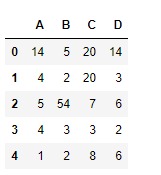
让我们创建系列
# importing pandas as pd
import pandas as pd
# create series
sr = pd.Series([3, 2, 4, 5, 6])
# Print series
sr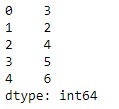
让我们使用dataframe.mul()执行乘法的函数
# find multiplication over the index axis
df1.mul(sr, axis = 0)输出:
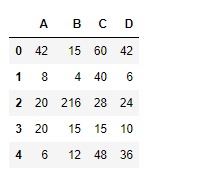
范例2:采用mul()函数查找两个datframe的乘法。一个 DataFrame 包含NA值。
# importing pandas as pd
import pandas as pd
# Creating the first dataframe
df1=pd.DataFrame({"A":[14,4,5,4,1],
"B":[5,2,54,3,2],
"C":[20,20,7,3,8],
"D":[14,3,6,2,6]})
# Creating the second dataframe with <code>Na</code> value
df2=pd.DataFrame({"A":[12,4,5,None,1],
"B":[7,2,54,3,None],
"C":[20,16,11,3,8],
"D":[14,3,None,2,6]})
# Print the second dataframe
df2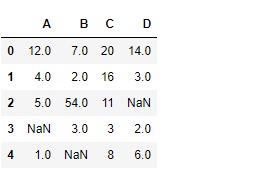
让我们使用dataframe.mul()函数查找两个数据帧的乘法,还处理缺失值。
# fill the missing values with 100
df1.mul(df2, fill_value = 100)输出:
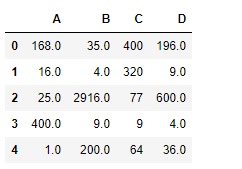
请注意,所有缺失值单元格在相乘之前已填充100
相关用法
- Python pandas.map()用法及代码示例
- Python Pandas Series.str.len()用法及代码示例
- Python Pandas.factorize()用法及代码示例
- Python Pandas TimedeltaIndex.name用法及代码示例
- Python Pandas dataframe.ne()用法及代码示例
- Python Pandas Series.between()用法及代码示例
- Python Pandas DataFrame.where()用法及代码示例
- Python Pandas Series.add()用法及代码示例
- Python Pandas.pivot_table()用法及代码示例
- Python Pandas Series.mod()用法及代码示例
- Python Pandas Dataframe.at[ ]用法及代码示例
- Python Pandas Dataframe.iat[ ]用法及代码示例
- Python Pandas.pivot()用法及代码示例
- Python Pandas.melt()用法及代码示例
- Python Pandas Series.dt.tz用法及代码示例
注:本文由纯净天空筛选整理自Shubham__Ranjan大神的英文原创作品 Python | Pandas dataframe.mul()。非经特殊声明,原始代码版权归原作者所有,本译文未经允许或授权,请勿转载或复制。
